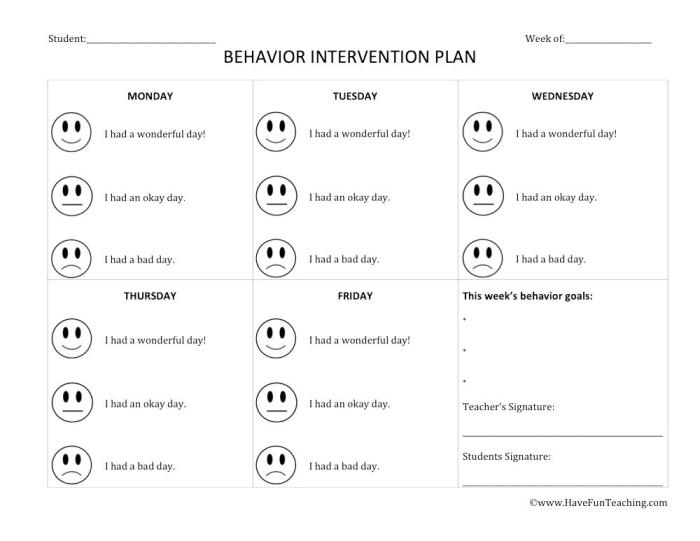As RBTs are responsible for knowing a child’s behavior intervention plan takes center stage, this opening passage beckons readers into a world crafted with good knowledge, ensuring a reading experience that is both absorbing and distinctly original. With a comprehensive exploration of the topic, this article delves into the multifaceted role of RBTs, shedding light on their crucial responsibilities and the ethical considerations they must navigate.
RBTs, or Registered Behavior Technicians, play a pivotal role in the lives of children with behavioral challenges. They are responsible for implementing behavior intervention plans, which are designed to help children learn appropriate behaviors and reduce challenging ones. RBTs work closely with other professionals, such as psychologists and speech-language pathologists, to develop and implement these plans.
Understanding the Role of RBTs in Behavior Intervention Plans
Registered Behavior Technicians (RBTs) play a crucial role in implementing behavior intervention plans (BIPs) for children with behavior challenges. Their primary responsibilities include:
- Conducting assessments to identify the antecedents and consequences of challenging behaviors
- Developing and implementing behavior intervention strategies based on evidence-based practices
- Monitoring and evaluating the progress of BIPs
- Collaborating with other professionals, such as psychologists, speech therapists, and occupational therapists, to develop comprehensive intervention plans
Collaboration among professionals is essential to ensure that all aspects of a child’s needs are addressed. RBTs work closely with other professionals to gather information, share insights, and coordinate interventions.
Assessing a Child’s Behavior

RBTs use a variety of methods to assess a child’s behavior, including:
- Direct observation: Observing the child’s behavior in different settings and situations
- Interviews: Conducting interviews with parents, teachers, and other caregivers to gather information about the child’s behavior
- Record reviews: Reviewing existing records, such as school reports and medical records, to gather information about the child’s behavior and developmental history
The type of assessment used will depend on the specific needs of the child and the purpose of the assessment.
Developing a Behavior Intervention Plan
The development of a BIP involves several steps:
- Conducting a comprehensive assessment to gather information about the child’s behavior and needs
- Setting goals and objectives for the BIP based on the assessment findings
- Developing intervention strategies that are tailored to the child’s individual needs
- Implementing the BIP and monitoring its progress
- Evaluating the effectiveness of the BIP and making adjustments as needed
RBTs play a key role in each step of the process, working closely with other professionals and the child’s family to develop and implement an effective BIP.
Implementing a Behavior Intervention Plan
RBTs use a variety of strategies and techniques to implement BIPs, including:
- Positive reinforcement: Providing rewards or praise for desired behaviors
- Negative reinforcement: Removing or avoiding negative consequences for desired behaviors
- Punishment: Using negative consequences for undesired behaviors
- Extinction: Ignoring undesired behaviors
- Time-out: Removing the child from a situation for a short period of time
The specific strategies used will depend on the individual needs of the child and the goals of the BIP.
Collaboration with Parents and Caregivers

Collaboration with parents and caregivers is essential for the success of a BIP. RBTs work closely with parents and caregivers to:
- Explain the BIP and its goals
- Provide training on how to implement the BIP
- Monitor the progress of the BIP and make adjustments as needed
- Address any concerns or questions that parents and caregivers may have
By working together, RBTs and parents and caregivers can create a supportive environment for the child and help them to achieve their goals.
Ethical Considerations: Rbts Are Responsible For Knowing A Child’s Behavior Intervention Plan

RBTs must always act in the best interests of the child. This includes respecting the child’s rights, ensuring their safety, and maintaining confidentiality. RBTs must also be aware of the potential for bias and discrimination and take steps to avoid these in their work.
Detailed FAQs
What is the role of an RBT?
RBTs are responsible for implementing behavior intervention plans, which are designed to help children learn appropriate behaviors and reduce challenging ones. They work closely with other professionals, such as psychologists and speech-language pathologists, to develop and implement these plans.
What are the qualifications to become an RBT?
To become an RBT, you must have a high school diploma or equivalent and complete a 40-hour training program. You must also pass the RBT exam.
What are the benefits of using a behavior intervention plan?
Behavior intervention plans can help children learn appropriate behaviors and reduce challenging ones. They can also help children improve their social skills, academic performance, and overall quality of life.